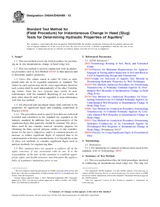We need your consent to use the individual data so that you can see information about your interests, among other things. Click "OK" to give your consent.
ASTM D4044/D4044M-15
Standard Test Method for (Field Procedure) for Instantaneous Change in Head (Slug) Tests for Determining Hydraulic Properties of Aquifers (Withdrawn 2024)
Automatically translated name:
Standard Test Method for (Field Procedure) for Instantaneous Change in Head (Slug) Tests for Determining Hydraulic Properties of Aquifers
STANDARD published on 1.9.2015
The information about the standard:
Designation standards: ASTM D4044/D4044M-15
Note: WITHDRAWN
Publication date standards: 1.9.2015
SKU: NS-615118
The number of pages: 4
Approximate weight : 12 g (0.03 lbs)
Country: American technical standard
Category: Technical standards ASTM
The category - similar standards:
Annotation of standard text ASTM D4044/D4044M-15 :
Keywords:
aquifer tests, aquifers, groundwater, hydraulic conductivity, hydraulic properties, instantaneous head test, slug tests, storage coefficient, transmissivity,, ICS Number Code 13.060.10 (Water of natural resources)
Additional information
| Significance and Use | ||||||||||||||||
|
5.1 This slug test field procedure is used in conjunction with a slug test analytical procedure, such as Test Method D4104 to provide quick and relatively inexpensive estimates of transmissivity. 5.2 The slug test provides an advantage over pumping tests in that it does not require the disposal of the large quantities of water that may be produced. This is of special importance when testing a potentially contaminated aquifer. However, slug tests reflect conditions near the well, therefore are influenced by near-well conditions, such as gravel pack, poor well development, and skin effects, as a result, slug test results should be viewed as semi-quantitative in comparison to pumping test results. 5.3 Slug tests may be made in aquifer materials of lower hydraulic conductivity than generally considered suitable for hydraulic testing with pumping tests. 5.4 The method of data analysis (analytical procedure) should be known prior to the field testing to ensure that all appropriate dimensions and measurements are properly recorded. Selection of the analytical procedure can be aided by using Guide D4043, Test Method D5785, Test Method D5881, and Test Method D5912. Note 1: The quality of the result produced by this standard is
dependent on the competence of the personnel performing it, and the
suitability of the equipment and facilities used. Agencies that
meet the criteria of Practice D3740 are generally considered capable of
competent and objective testing/sampling/inspection/etc. Users of
this standard are cautioned that compliance with Practice
D3740 does not in itself
assure reliable results. Reliable results depend on many factors;
Practice D3740 provides a
means of evaluating some of those factors.
|
||||||||||||||||
| 1. Scope | ||||||||||||||||
|
1.1 This test method covers the field procedure for performing an in situ instantaneous change in head (slug) test. 1.2 This test method is used in conjunction with an analytical procedure such as Test Method D4104 to data analysis and to determine aquifer properties. 1.3 Units—The values stated in either SI Units or inch-pound units are to be regarded separately as standard. The values in each system may not be exact equivalents; therefore each system shall be used independently of the other. Combining values from the two systems may result in non-conformance with the standard. Reporting of test results in units other than SI shall not be regarded as nonconformance with this test method. 1.4 All observed and calculated values shall conform to the guidelines for significant digits and rounding established in Practice D6026. 1.4.1 The procedures used to specify how data are collected/recorded and calculated in the standard are regarded as the industry standard. In addition, they are representative of the significant digits that generally should be retained. The procedures used do not consider material variation, purpose for obtaining the data, special purpose studies, or any considerations for the user’s objectives; and it is common practice to increase or reduce significant digits of reported data to be commensurate with these considerations. It is beyond the scope of these test methods to consider significant digits used in analysis methods for engineering data. 1.5 This standard does not purport to address all of the safety concerns, if any, associated with its use. It is the responsibility of the user of this standard to establish appropriate safety and health practices and determine the applicability of regulatory limitations prior to use. |
||||||||||||||||
| 2. Referenced Documents | ||||||||||||||||
|
We recommend:
Technical standards updating
Do you want to make sure you use only the valid technical standards?
We can offer you a solution which will provide you a monthly overview concerning the updating of standards which you use.
Would you like to know more? Look at this page.




 Cookies
Cookies
